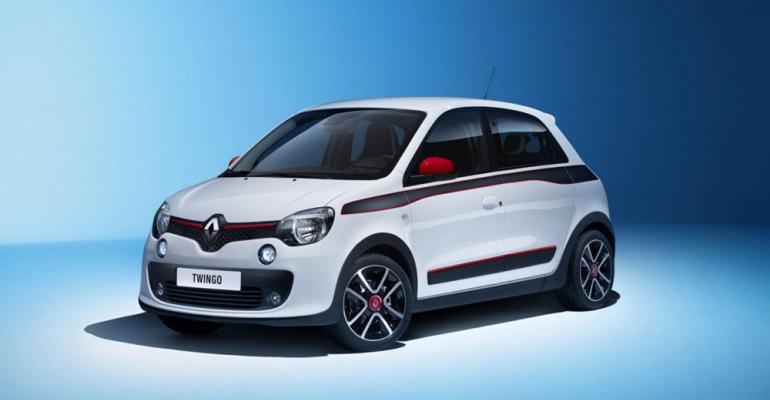The all-new Renault Twingo city car, the first fruit of the French automaker’s alliance with Daimler, is ready for production and commercial launch.
Developed in association with Daimler’s Smart city-car sub-brand, the Twingo features all-at-rear architecture, in which the engine is placed in the rear and drives the rear wheels.
The new layout, considered by Volkswagen but dismissed because of its higher production costs, gives the new Twingo a wheelbase and interior roominess on par with those of higher-segment competitors. All-at-rear also considerably improves the turning circle and agility.
Renault and Daimler agreed in 2010 to jointly develop both the new Twingo and next-generation 2- and 4-seat Smart. The French car is larger: it is 141.6 ins. (3,600 mm) long, 67.1 ins. (1,705 mm) wide and 59.2 ins. (1,505 mm) high.
Concepts called the Twin’Z and Twin’Run have been displayed at several events since March 2013, but the successor to the 20-year-old Twingo will be revealed in its production-ready form at next month’s Geneva auto show.
A 4-door Twingo will be offered at launch, leaving Smart alone in meeting the demand for a small 2-door city car, at least until the German brand is ready to launch its own 5-door ForFour, soon to enter production after a concept was previewed at the last Frankfurt auto show. At that time Renault expects to launch its 2-door Twingo.
The rear-powertrain/rear-drive architecture of the new, 4-door Smart that replaces the unsuccessful first-generation “ForFour,” built in association with Mitsubishi, recalls the original Smart package. For Renault, the new layout harkens all the way back to the 1960s, when the automaker produced the all-at-rear Renault 8.
Renault’s contribution to the current joint project with Daimler includes powertrains shared by its mass-produced compact Renault and Dacia models. The Twingo at launch will offer two turbocharged 0.9L and 1.2L TCe gasoline engines in 3- and 4-cyl. versions making 74 to 121 hp.
Laurens van den Acker, head of Renault design, and his team give the new Twingo brand character through the raked glass at the rear, inspired by the typical Renault 5 design and the optional soft-top folding roof of the iconic Renault 4.
The design evokes that of the original Twingo, but its profile mimics that of the Fiat 500. Indeed,
Fiat already is responding with a design update to be revealed at the Geneva show.





